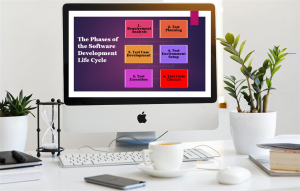6 Phases of Software Testing Life Cycle
- 2024-03-09 12:00:00
- Gregory Batchelor
- Original 643
We’d all like a world where you decide what features you want, send it across to the development team, and wait a few weeks until it’s ready. Perhaps your operations team might have a quick click through a few menus out of curiosity, and then whoosh! Off it goes to your customers, bug-free and ready to amaze with its wealth of new shiny features.
Unfortunately, we live in this reality where, no matter how good your development team is, bits will always get missed. Fortunately, this world also contains the Software Testing Life Cycle (STLC), a series of phases dedicated to ensuring the quality and performance of your software.
In this article, we’re going to look at the 6 phases of the STLC and show how following the process will lead to more usable, reliable, and efficient software. We shall also look at how project management tools, such as ZenTao, can help seamlessly integrate these phases into your chosen software development methodology, and suggest other technologies that could help you during the process.
The Phases of the Software Testing Life Cycle
Image Source:Pexels - Edited by the author
1. Requirement Analysis
Key Activities
- Identifying testable requirements
- Prioritizing the specified testing requirements
- Assessing the feasibility of the testing requirements
- Evaluate the feasibility of automation
- Create a requirement traceability matrix
- Creating a list of questions for clarification from clients or stakeholders
During this analysis phase, project management software can help by providing comprehensive documentation. It can also aid collaboration discussions to establish clear testing objectives by providing one centralized reference point for the entire testing cycle.
Larger teams or teams working remotely may also benefit from cloud-based PaaS software to aid collaborations by not only giving all QA team members centralized access but also giving the development team access to a cloud-based application development platform.
2. Test Planning
Once you have identified what testing is required, the next stage is to develop a plan to define the scope of the project and create a roadmap for the remaining phases. A careful, detailed plan will not only ensure that you don’t miss anything but will keep you and your team focused, saving you time in the long run.
Additionally, it's important to streamline customer onboarding to ensure that the testing process aligns with delivering a seamless experience to new customers.
Key Activities
- Defining objectives and scope of testing
- Selection of testing types, as well as specific approaches for each – this could be anything ranging from performance testing, to monitor processor access, to stress-testing hit ratios to find out how SQL statements are handled by cached data during busy periods – so long as they are testable and measurable.
- Determining and assigning roles and responsibilities
- Identifying testing resources and required equipment
- Identifying any training requirements
- Selection of appropriate testing tools
- Estimating time and effort for testing activities
- Performing a risk analysis
In this phase, project management software can help with resource allocation, timeline setting, and risk assessment, ensuring a well-defined roadmap for the testing process.
3. Test Case Development
Image Source: Pexels
Now it’s time to dig into the details and verify test cases and test scripts. The idea is that the test data is identified and reviewed based on the preconditions you outlined in the first two stages.
Key Activities
- Designing, creating, reviewing, and approving test cases
- Examining, revising, and approving existing relevant test cases
- Developing, reviewing, and approving automation scripts (if applicable)
The Test Case Development phase benefits from organized management of test cases and scripts – management software can help by providing a structure for each test case, ensuring uniformity of data at the end of the process.
Additionally, if you are managing a remote team, remember that you can also keep track of progress by using workflow software, which can allow you to access your project management software wherever you are.
4. Test Environment Setup
Key Activities
- Setting up the test data
- Gathering necessary hardware and software, creating a test environment checklist
- Configuring network settings and setting up a test server
- Outlining the process for managing and maintaining test environments
- Conducting smoke testing to ensure the environment's readiness
In the Test Environment Setup, software can help track the readiness of hardware and software configurations. Creating management checklists can also help ensure all required components are in place before you move onto the execution phase, ensuring you stay on track to project management success.
In the Test Environment Setup, it's important to consider the use of advanced technology, like AI content detection tools as part of your testing process. These tools can play a significant role in identifying and flagging any content within the test environment that may have been generated or influenced by artificial intelligence, ensuring the accuracy and integrity of your testing data.
5. Test Execution
Key Activities
- Executing test cases according to the test plan
- Comparing actual outcomes with expected results
- Identifying and documenting discrepancies as defects
- Logging defects in bug-tracking systems
- Mapping defects to test cases in the traceability matrix
- Retesting defect fixes
- Performing regression testing (if required)
- Tracking defects until resolution
During Test Execution, project management software becomes crucial for monitoring test progress, documenting results, and tracking defects. Data sharing services can also be crucial during this stage to allow test results to be easily shared between teams in real-time, reducing the time required to address issues.
6. Test Cycle Closure
Image Source: Pexels
Finally, the test cycle closure phase is where you ensure that you’ve completed all the testing you set out to do and finalize your test completion reporting to the stakeholders and design teams. It is also an opportunity to analyze the success of the STLC to try and avoid any problems you encountered during the process.
Key Activities
- Reviewing the entire testing process
- Discussing potential modifications to exit criteria, test plan, and test cases
- Analyzing and examining test results
- Compiling all test deliverables, including test plan, strategy, cases, etc.
- Creating test metrics and the test closure report
- Prioritizing defects based on severity and impact
In the Test Cycle Closure phase, project management software supports in-depth analysis and reporting. However, remember that this phase isn’t just about filling out the paperwork to wrap up the project – it’s about learning and improving.
Set up meetings to find out what problems, if any, your team encountered. A cloud telephone system can help here by allowing you to communicate with your whole team so everyone can share what they have learned from the process.
Conclusion
Integrating the software testing life cycle into your project management is critical to ensure that you can successfully deliver high-quality, bug-free software that performs the way you want it to. Using a methodological approach will not just save you time and effort. Your customers will also love the reliability, consistency, and performance of the software you send them.
Products
- ZDOO
- ZDOO Cloud
Support
- Book a Demo
- Tech Forum
- GitHub
- SourceForge
About Us
- Company
- Privacy Policy
- Term of Use
- Blogs
- Partners
Contact Us
- Leave a Message
- Email Us: support@zentaoalm.com









